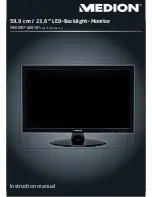
15
9. Power-saving
options
This monitor switches to different power-saving modes which are specified by the respective computer/operating sys-
tem. This complies with the current requirements for reducing the energy consumption.
The monitor supports the following types of power-saving modes:
Status
Power consumption (nominal
value)
Colour of
operating light
Standby (approx.)
ON
READY
30 watts (max.)
< 0,5 watt
green
orange
-
2 seconds
Depending on the operating system, the monitor remains in the power-saving mode until you press a key or move the
mouse (if available).
To switch from the
READY
state to the
ON
operating mode, the monitor needs roughly 2 seconds.
10. Customer service
10.1. Troubleshooting
If problems occur with your monitor, make sure that the monitor has been properly installed. If the problems persist,
then read this chapter for information about possible solutions.
10.1.1. Check cables and connections
Start by carefully checking all the cable connections. If the power indicator lights are not on, ensure that the monitor
and the computer are properly connected to the power supply.
10.1.2. Faults and possible causes
10.1.3.
The monitor does not show a picture:
Check:
•
Power supply
: The mains cable must firmly inserted in the socket must be switched on.
•
Signal source
: Please check if the signal source (computer or similar) is switched on and that the connection cables
are firmly inserted in the sockets.
•
Refresh rates
: The current refresh rate must be suitable for the monitor.
•
Power-saving mode
: Press any key or move the mouse to deactivate the mode.
•
Screen saver
: If the computer’s screen saver is activated, press any key on the keyboard or move the mouse.
•
Signal connector: If the pins are bent, contact your customer service.
•
Set the applicable values for your monitor.
10.1.4. The picture flickers up/down or is inconsistent:
Check:
•
Signal connector
: If the pins are bent, contact your customer service.
•
Signal connector
: The connectors of the signal cable must be inserted firmly in the sockets.
•
Graphics card
: Check if the settings are correct.
•
Refresh rates
. Select valid settings in your graphics settings.
•
Monitor output signal
. The monitor output signal of the computer must match the technical data of the monitor.
•
Remove disruptive devices (cordless phones, loudspeakers or similar) from the environment of the monitor.
•
Avoid using monitor extension cables.
10.1.5. Characters are shown dark, the picture is too small, too big, or not centred, etc.:
•
Adjust the respective settings.
10.1.6. Colours are not shown cleanly:
•
Check the signal cable pins. If the pins are bent, contact your customer service.
•
Adjust the colour settings in the OSD menu.
•
Avoid using monitor extension cables.
10.1.7. The display is too bright or too dark:
•
Check if the video output level of the computer matches the technical data of the monitor.
•
Select Autom. adjustment to optimise the settings for brightness and contrast. For optimisation, the display
should show a text page (e.g. Explorer, Word, ...).






































